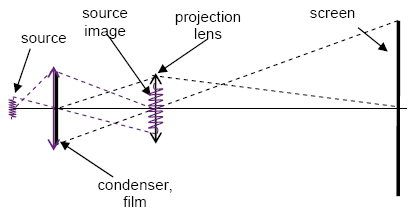Optipedia • SPIE Press books opened for your reference.
Köhler Illumination
Excerpt from Field Guide to Illumination
Köhler illumination is used when the source is not uniform, such as a coiled tungsten filament. Köhler illumination is characterized by imaging the source through the film onto the projection lens. The film is placed adjacent to the condenser, where the illumination is quite uniform, provided the source has a relative uniform angular distribution of intensity.
The paraxial layout below shows Köhler illumination used in a projection system. The source is imaged by a condenser onto the projection lens. The projection objective images the film onto the screen. The purple dotted lines show the marginal and chief rays from the source. The black dotted lines show the marginal and chief rays from the film.

| With similar sources, similar condenser NAs, source/condenser étendue as limiting étendue, and similar screen sizes, the average screen irradiance levels are the same for both Abbe and Köhler illumination systems. The choice between the two generally depends upon the type of source available. |
A. V. Arecchi, T. Messadi, and R. J. Koshel, Field Guide to Illumination, SPIE Press, Bellingham, WA (2007).
View SPIE terms of use.
Non-Member: $42.00

